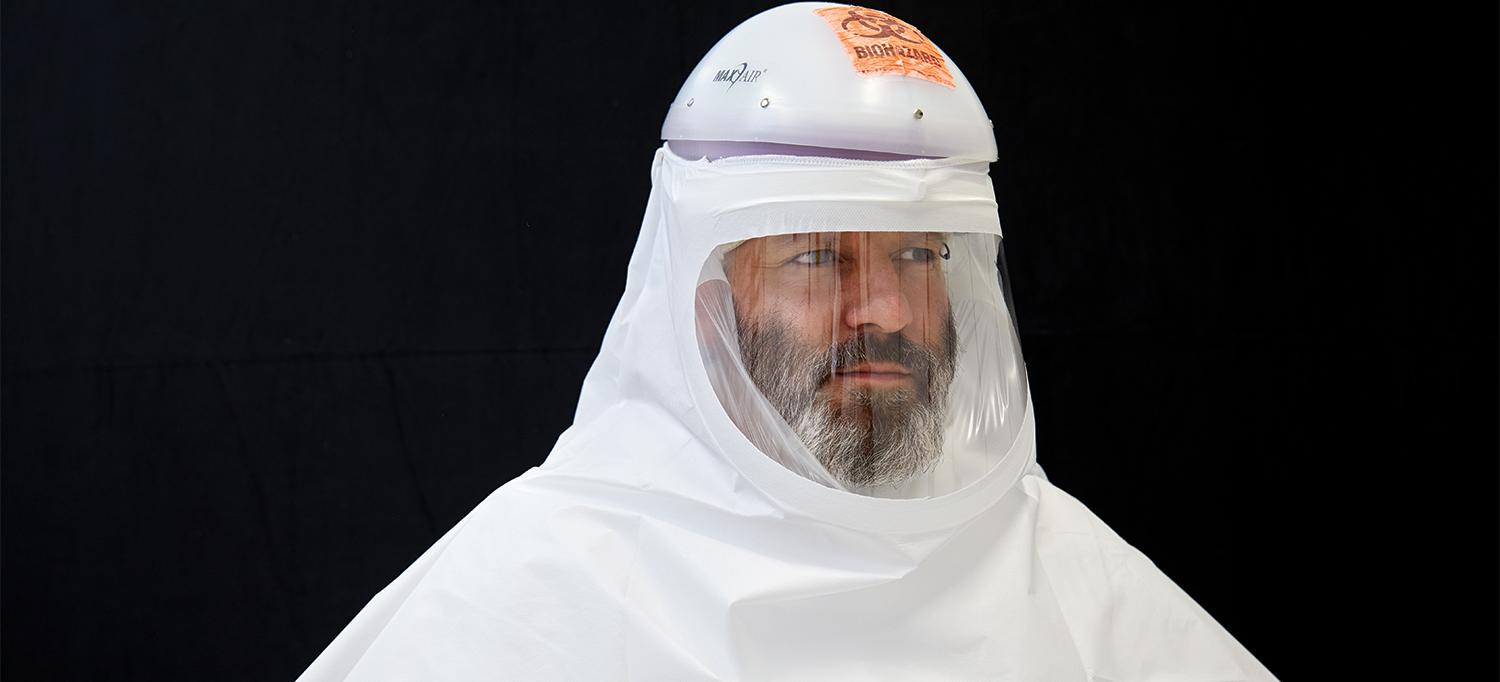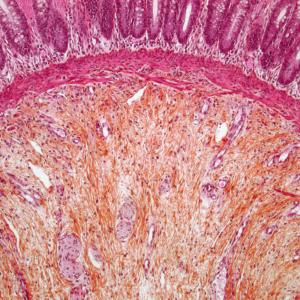
Dr. Ludovic Desvignes leads NYU Langone’s high-containment facility, where scientists work in “space suits” to protect them from infection.
Photo: Jonathan Kozowyk
Ever since COVID-19 made its mysterious and deadly debut in New York City last spring, researchers at NYU Grossman School of Medicine have been at the forefront of scientific investigations to demystify the pathogen and help give doctors the upper hand in treating it.
But how exactly do you safely study a highly contagious virus that has killed more than 3.8 million people worldwide? The answer lies within a special type of research facility known as a high-containment lab, or an ABSL-3, short for Animal Biosafety Level 3.
Since 2016, when NYU Langone Health opened its newest and largest ABSL-3 facility, its researchers have been securely studying tuberculosis, chikungunya, hantavirus, and other contagious pathogens that require extra layers of precautions and regulations to handle them safely. So, when COVID-19 emerged, NYU Langone researchers were fast off the blocks. By February, the Vaccine Center had already secured the SARS-CoV-2 strain circulating in Washington state from the Centers for Disease Control and Prevention and begun studying how the virus infects humans—and might be thwarted by vaccines or drugs. “Without our existing ABSL-3 facility, NYU Langone simply wouldn’t have been able to join in the global research effort on SARS-CoV-2,” says Ludovic P. Desvignes, PhD, director of NYU Langone’s High-Containment Laboratories.
The facility has so far yielded a wellspring of scientific insights. In one recently published study, Kenneth A. Stapleford, PhD, assistant professor of microbiology, and colleagues collected blood serum from a group of 101 healthcare workers at NYU Langone who had recovered from COVID-19 and volunteered for a study to determine whether their infections might afford some protection against reinfection. Within the protective confines of the ABSL-3 facility, the team mixed dilutions of antibodies from the volunteers’ blood with dilutions of the virus, allowed them to incubate, and then added the mix to cultured monkey cells to see whether the antibodies could block the virus.
The researchers found that a robust and diverse antibody response best protected the monkey cells from being infected in the lab. “One take-home message is that you need lots of different types of antibodies in order to get the best blockage of the virus after infection,” Dr. Stapleford explains. He notes that the post-infection mechanism, though, seems to be quite different than the post-vaccination mechanism, which largely relies on only one type of antibody production to block the virus.
In another major study that could only have been conducted in an ABSL-3 facility, researchers found that an experimental compound called PF-00835231, provided by Pfizer as part of a collaboration, may offer a new therapeutic against SARS-CoV-2 by targeting an essential viral enzyme called 3CLpro. “Shutting down the enzyme means shutting down the progression to viral replication,” says Meike Dittmann, PhD, assistant professor of microbiology.
In tests on genetically engineered stand-ins for human lung cells, Dr. Dittmann and colleagues found that the drug inhibits the virus at least as well as remdesivir, the only U.S. Food and Drug Administration (FDA)–approved antiviral currently available to treat patients with COVID-19. The researchers confirmed the drug’s efficacy with another type of cell culture that recreates the lung tissue’s 3D structure in a dish, or organoids. Moreover, the enzyme targeted by the drug is well conserved among known SARS-CoV-2 variants, suggesting that the drug could work on all of them. Based on these positive results, Pfizer is following up with clinical trials of the drug.
“Any time you’re looking at an immune response or something a virus triggers, you really have to use the live virus,” says Dr. Stapleford. “So the ABSL-3 has been instrumental in enabling us to see what this virus actually does to cells.”
The Higher the Risk, the Hardier the Lab: Four Levels of Biosafety Facilities
Laboratories where biological agents are studied are classified by the level of containment they require for safety. There are four levels of biosafety labs, ranging from those that house low-risk pathogens, Biosafety Level 1 (BSL-1), to the highest risk microbes, Biosafety Level 4 (BSL-4).
Biosafety Level 1 (BSL-1)
For research with agents that usually don’t cause disease in healthy adults, and pose minimal potential hazard to laboratory personnel and the community. Examples include a nonpathogenic strain of Escherichia coli.
Biosafety Level 2 (BSL-2)
For research with agents that can cause mild disease in healthy humans or are difficult to contract through inhalation, and present moderate potential risk to laboratory personnel and the community. Examples include herpes simplex virus, rhinoviruses, respiratory syncytial virus (RSV), Staphylococcus aureus, and Salmonella. Access is restricted, and appropriate personal protective equipment is required.
Biosafety Level 3 (BSL-3)
For research with agents that can cause serious or potentially lethal disease through inhalation, and pose a significant potential risk to laboratory personnel and the community. Examples include Mycobacterium tuberculosis, SARS-CoV-2, Bacillus anthracis (anthrax), and West Nile virus.
Access to a BSL-3 laboratory is restricted, and the lab is equipped with self-closing, interlocking doors, sealed windows, devices to decontaminate infectious waste, a HEPA-filtered ventilation system, and directional air flow that draws air into the laboratory from clean areas. Work is performed in biosafety cabinets, and extensive personal protective equipment is required, including disposable gloves, a powered air purifying respirator (PAPR), and a full body suit.
Biosafety Level 4 (BSL-4)
For research with agents that can cause life-threatening disease to humans, with no vaccines or treatments available. Such agents pose a high risk of infection through inhalation and constitute a high risk to laboratory personnel and the community. Examples include Ebola virus and smallpox virus. In addition to the design specifications and safety precautions required by a BSL-3 lab, a BSL-4 lab is located in a separate building or in an isolated and restricted zone, with dedicated supply and exhaust ventilation.
Work is performed in a Class III biosafety cabinet, also known as a glovebox, and wearing a full body, tear-resistant, air-supplied positive pressure protective suit. Upon entry, a complete change of clothing is required; upon exit, showering and decontamination of all materials are required.
